Preparation of High-Precision Dimension Seamless Thick-Walled Pipe by New Cold Rolling Process
Abstract
:1. Introduction
2. Materials and Methods
2.1. Experimental Material
2.2. Pilger Rolling and Heat Treatment
2.3. Experimental Method
3. Results
3.1. Quality of Pipe after Rolling

| pc | The normal pressure per unit area of the roll (mandrel) on the pipe | |
| σb | strength of the mother pipe under different deformations | Figure 6 |
| nσ | coefficient of principal stress | 1.02~1.08 [11] |
| f | coefficient of friction between roller(mandrel) and pipe | 0.1 [11] |
| S0 | the wall thickness of the mother pipe | 14 mm |
| Sx | pipe wall thickness at position x | Table 5 |
| Sx | the instantaneous reduction in wall thickness at position x | |
| x | roll groove radius at position x | Table 5 |
| w | the radius of the drive gear pitch | 140 mm |
| μx | rolling elongation coefficient of pipe at x | |
| γx | taper between any x and x + 1 positions at the ridge of the roll groove | Table 5 |
| αx | taper between any x and x + 1 positions at the ridge of the mandrel | Table 5 |
| Rx | groove radius at any x position of the roll groove | Table 5 |
| rx | radius at any x position of the mandrel | Table 5 |
| D0 | The outer diameter of the mother pipe | 46 mm |
| Dx | pipe outer diameter at position x | Table 5 |
| Lx | distance between any x and x + 1 positions at the ridge of the roll groove | 10 mm |
| lx | distance between any x and x + 1 positions at the mandrel | 20 mm |
| Dx (mm) | Rx (mm) | ρx (mm) | γx (mm) | rx (mm) | αx (mm) | Sx (mm) |
|---|---|---|---|---|---|---|
| 42.514 | 20.257 | 129.743 | 0.0763 | 7.377 | 0.0082 | 13.88 |
| 41.805 | 19.902 | 130.098 | 0.0709 | 7.2975 | 0.00795 | 13.605 |
| 41.149 | 19.575 | 130.425 | 0.0656 | 7.22 | 0.00775 | 13.3545 |
| 40.546 | 19.273 | 130.727 | 0.0603 | 7.145 | 0.0075 | 13.128 |
| 39.997 | 18.998 | 131.002 | 0.0549 | 7.072 | 0.0073 | 12.9265 |
| 39.499 | 18.75 | 131.25 | 0.0498 | 7.001 | 0.0071 | 12.7485 |
| 39.054 | 18.527 | 131.473 | 0.0445 | 6.932 | 0.0069 | 12.595 |
| 38.66 | 18.33 | 131.67 | 0.0394 | 6.865 | 0.0067 | 12.465 |
| 38.316 | 18.158 | 131.842 | 0.0344 | 6.8 | 0.0065 | 12.358 |
| 37.996 | 17.998 | 132.002 | 0.032 | 6.7365 | 0.00635 | 12.2615 |
| 37.689 | 17.844 | 132.156 | 0.0307 | 6.675 | 0.00615 | 12.1695 |
| 37.395 | 17.698 | 132.302 | 0.0294 | 6.6155 | 0.00595 | 12.082 |
| 37.115 | 17.558 | 132.442 | 0.028 | 6.5575 | 0.0058 | 12 |
| 36.848 | 17.424 | 132.576 | 0.0267 | 6.5015 | 0.0056 | 11.9225 |
| 36.592 | 17.296 | 132.704 | 0.0256 | 6.4465 | 0.0055 | 11.8495 |
| 36.349 | 17.175 | 132.825 | 0.0243 | 6.3935 | 0.0053 | 11.781 |
| 36.118 | 17.059 | 132.941 | 0.0231 | 6.342 | 0.00515 | 11.717 |
| 35.898 | 16.949 | 133.051 | 0.022 | 6.292 | 0.005 | 11.657 |
| 35.689 | 16.845 | 133.155 | 0.0209 | 6.243 | 0.0049 | 11.6015 |
| 35.491 | 16.745 | 133.255 | 0.0198 | 6.1955 | 0.00475 | 11.55 |
| 35.303 | 16.651 | 133.349 | 0.0188 | 6.1495 | 0.0046 | 11.502 |
| 35.125 | 16.562 | 133.438 | 0.0178 | 6.1045 | 0.0045 | 11.458 |
| 34.957 | 16.478 | 133.522 | 0.0168 | 6.0605 | 0.0044 | 11.418 |
| 34.797 | 16.399 | 133.601 | 0.016 | 6.018 | 0.00425 | 11.3805 |
| 34.647 | 16.324 | 133.676 | 0.015 | 5.976 | 0.0042 | 11.3475 |
| 34.505 | 16.253 | 133.747 | 0.0142 | 5.9355 | 0.00405 | 11.317 |
| 34.372 | 16.186 | 133.814 | 0.0133 | 5.8955 | 0.004 | 11.2905 |
| 34.246 | 16.123 | 133.877 | 0.0126 | 5.8565 | 0.0039 | 11.2665 |
| 34.127 | 16.063 | 133.937 | 0.0119 | 5.8185 | 0.0038 | 11.245 |
| 34.015 | 16.008 | 133.992 | 0.0112 | 5.781 | 0.00375 | 11.2265 |
| 33.91 | 15.955 | 134.045 | 0.0105 | 5.7445 | 0.00365 | 11.2105 |
| 33.811 | 15.905 | 134.095 | 0.0099 | 5.7085 | 0.0036 | 11.197 |
| 33.717 | 15.859 | 134.141 | 0.0094 | 5.6725 | 0.0036 | 11.186 |
| 33.629 | 15.815 | 134.185 | 0.0088 | 5.6375 | 0.0035 | 11.177 |
| 33.546 | 15.773 | 134.227 | 0.0083 | 5.603 | 0.00345 | 11.17 |
| 33.467 | 15.734 | 134.266 | 0.0079 | 5.5685 | 0.00345 | 11.165 |
| 33.392 | 15.696 | 134.304 | 0.0075 | 5.534 | 0.00345 | 11.162 |
| 33.321 | 15.661 | 134.339 | 0.0071 | 5.5 | 0.0034 | 11.1605 |
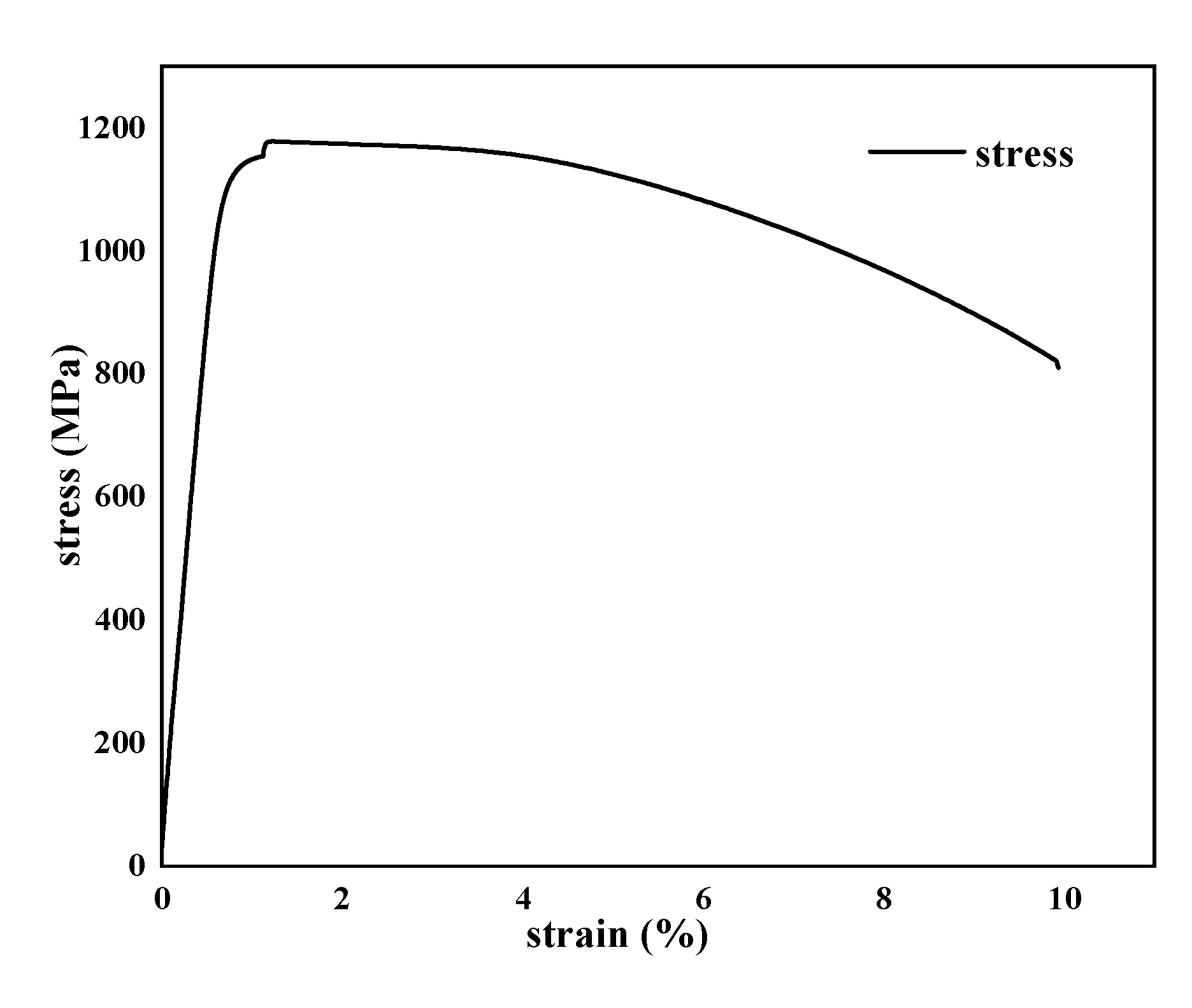
3.2. Microstructure Analysis
3.3. Mechanical Properties
4. Discussion
4.1. Inner Surface Roughness of Pipe after Rolling
4.2. Microstructure and Mechanical Properties
4.3. Comparison of Three Preparation Process
5. Conclusions
- (1)
- Pilger cold rolling was performed to produce high-precision thick-walled and small-hole seamless steel pipes with a smaller diameter/thickness than 3, the inner and outer diameter tolerance less than 0.05 mm;
- (2)
- The relationship between the feed rate, normal pressure per unit area and inner wall roughness was analyzed. The results show that the feed rate is positively correlated with the normal pressure per unit area, and the increase in normal pressure per unit area is beneficial to reduce the inner wall roughness. When the normal pressure per unit area is up to 1058.4 MPa, inner wall roughness Ra ≤ 0.2 μm;
- (3)
- The microstructure of the mother pipe before rolling is tempered sorbite, and grain orientation is random distribution. After pilger rolling, the grain orientation is gradually focused on <101>, and the density of dislocations increased continuously, resulting in work hardening behavior and decrease in plasticity and toughness, after vacuum tempering the dislocation density decreases, the strength decreases, and the plasticity and toughness return to the level before rolling;
- (4)
- The preparation efficiency and the surface quality of the thick-walled pipe by new cold rolling is much better than the traditional machining process and traditional rolling process.
Author Contributions
Funding
Institutional Review Board Statement
Informed Consent Statement
Data Availability Statement
Conflicts of Interest
References
- Akasaki, H. Progress in pipe and pipe technology and its future prospect–application and manufacturing. Nippon Steel Tech. Rep. 2004, 90, 75–81. [Google Scholar]
- Huml, P.; Fogelholm, R.; Salwén, A. Optimization of cold rolling of precision pipes. CIRP Ann. 1993, 42, 283–286. [Google Scholar] [CrossRef]
- Abe, H.; Furugen, M. Method of evaluating workability in cold pilgering. J. Mater. Process. Technol. 2012, 212, 1687–1693. [Google Scholar] [CrossRef]
- Musazadeh, M.H.; Vafaei, R.; Mohammad Sharifi, E.; Farmanesh, K. Mechanical Properties, Microstructural Evolution, and the Effect of Friction on the Plastic Flow of the AISI 321 Austenitic Stainless Steel Tube During Cold Pilgering, An Experimental and Simulation Analysis. Metall. Mater. Trans. B 2018, 49, 3030–3042. [Google Scholar] [CrossRef]
- Huang, B.; Huang, Q.; Li, C.; Liu, S.; Wu, Q. Effects of pipe rolling and heat treatment on microstructure and mechanical properties of CLAM rectangular pipe. Fusion Eng. Des. 2011, 86, 2602–2606. [Google Scholar] [CrossRef]
- Gulyaev, Y.G.; Shifrin, E. Method of calculating the speed regime for continuous pipe rolling. Metallurgist 2014, 57, 904–910. [Google Scholar] [CrossRef]
- Carneiro, K.; Jensen, C.P.; Jørgensen, J.F.; Garnœs, J.; McKeown, P.A. Roughness parameters of surfaces by atomic force microscopy. CIRP Ann. 1995, 44, 517–522. [Google Scholar] [CrossRef]
- Abe, H.; Nomura, T.; Kubota, Y. Lubrication of tube in cold pilgering. J. Mater. Process. Technol. 2014, 214, 1627–1637. [Google Scholar] [CrossRef]
- Lin, H.S.; Marsault, N.; Wilson, W.R.D. A mixed lubrication model for cold strip rolling—Part I, Theoretical. Tribol. Trans. 1998, 41, 317–326. [Google Scholar] [CrossRef]
- Montmitonnet, P.; Farrugia, D.; Aubin, J.L.; Delamare, F. Internal surface roughness of cold pilgered zircaloy pipes. Wear 1992, 152, 327–342. [Google Scholar] [CrossRef]
- Yan, F.F. Pass Design of LG730 Cold-Rolling Pilger Milland Its Finite Element Simulation in the Rolling-Process. Master’s Thesis, Yanshan University, Qinhuangdao, China, 2015. [Google Scholar]
- Li, H.; Wei, D.; Zhang, H.Q.; Yang, H.; Liu, H.R.; Liu, S.T.; Chu, Z.B.; Zhang, D. Texture evolution and controlling of high-strength titanium alloy pipe in cold pilgering for properties tailoring. J. Mater. Process. Technol. 2020, 279, 116520. [Google Scholar] [CrossRef]
- Pociecha, D.; Boryczko, B.; Osika, J.; Mroczkowski, M. Analysis of pipe deformation process in a new pilger cold rolling process. Arch. Civ. Mech. Eng. 2014, 14, 376–382. [Google Scholar] [CrossRef]
- Li, X.; Zheng, J.; Yu, B.; Du, Y.; Zhou, Y. Analytical Model of Hole Diameter and Self-Guiding Machining Mechanism of BTA Deep Hole Drilling. Materials 2022, 15, 5329. [Google Scholar] [CrossRef] [PubMed]
- Lili, L. Study on Radial Forging Process of Barrel and Properties of Forged Barrel. Ph.D. Thesis, Nanjing University of Science and Technology, Nanjing, China, 2013. [Google Scholar]
- Tyagi, P.; Brent, D.; Saunders, T.; Goulet, T.; Riso, C.; Klein, K.; Moreno, F.G. Roughness reduction of additively manufactured steel by electropolishing. Int. J. Adv. Manuf. Technol. 2020, 106, 1337–1344. [Google Scholar] [CrossRef]
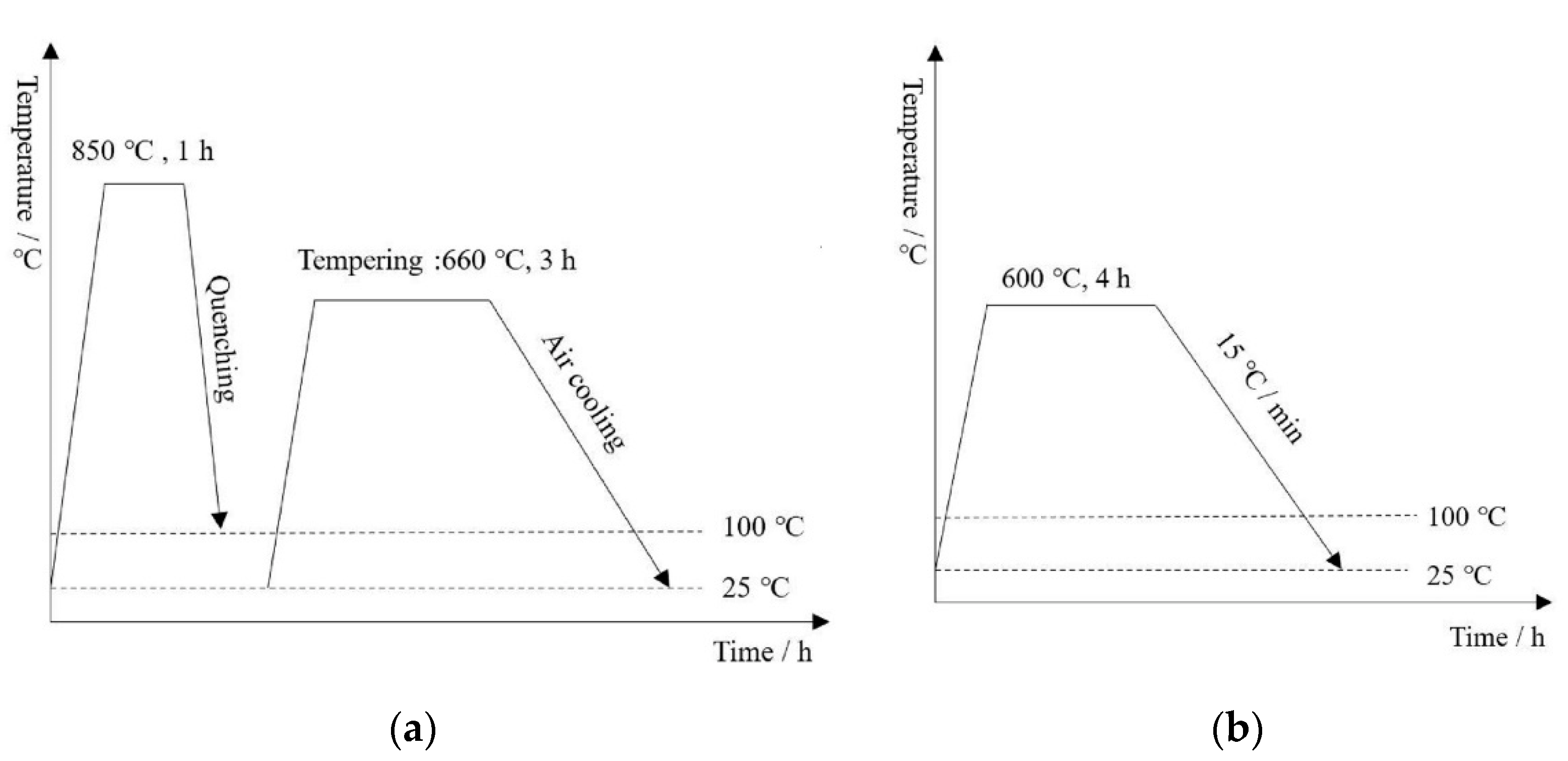


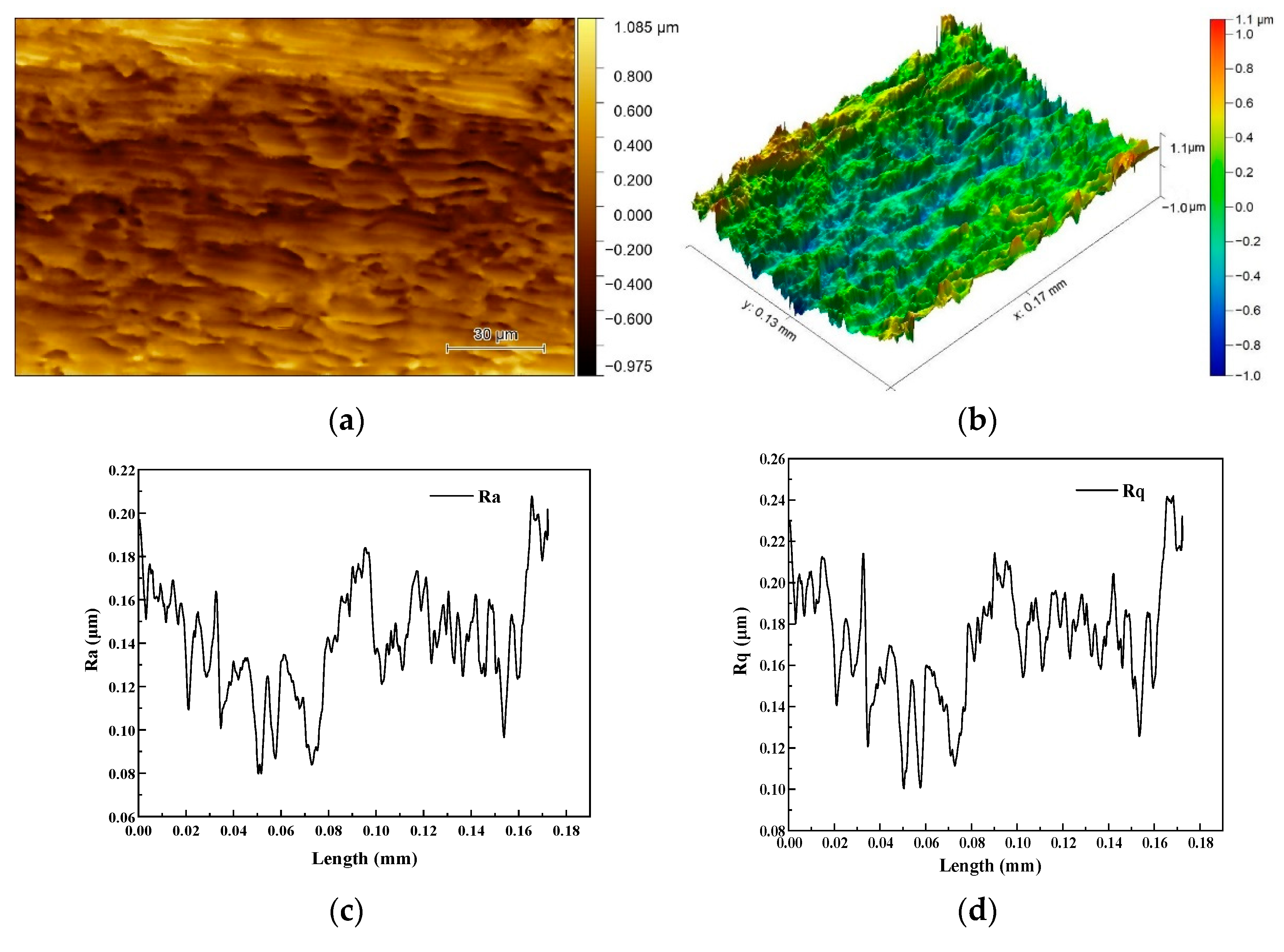
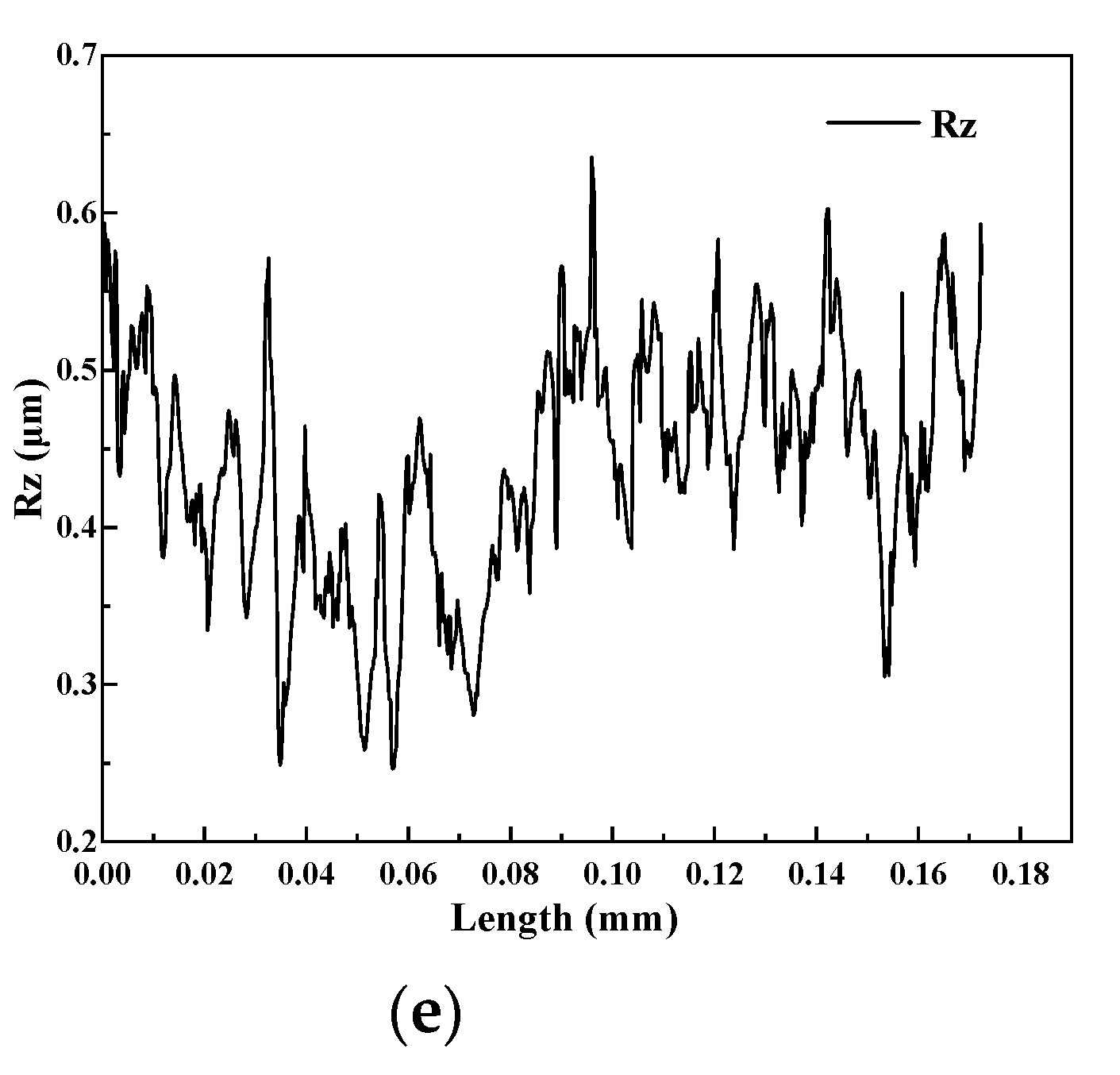
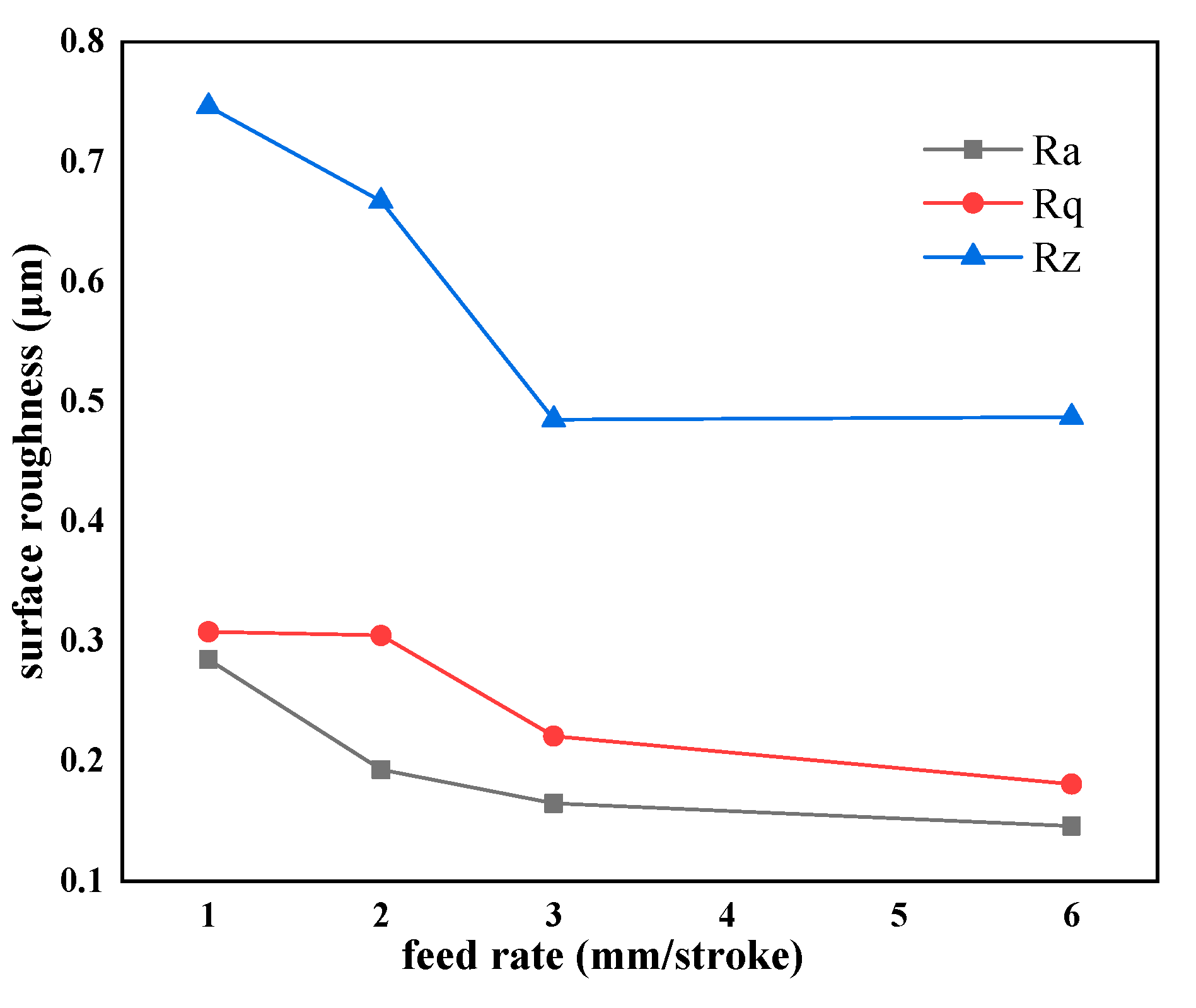
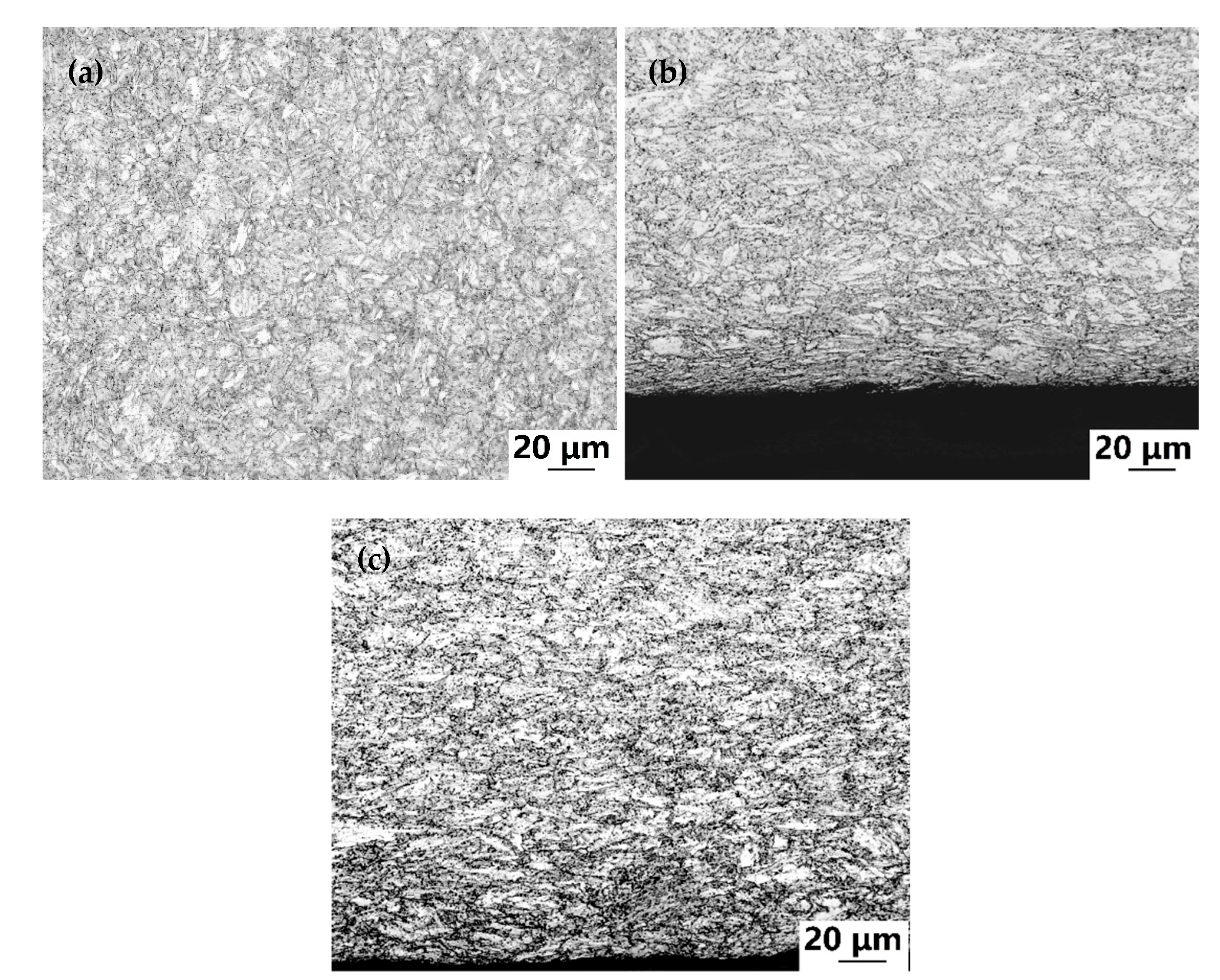


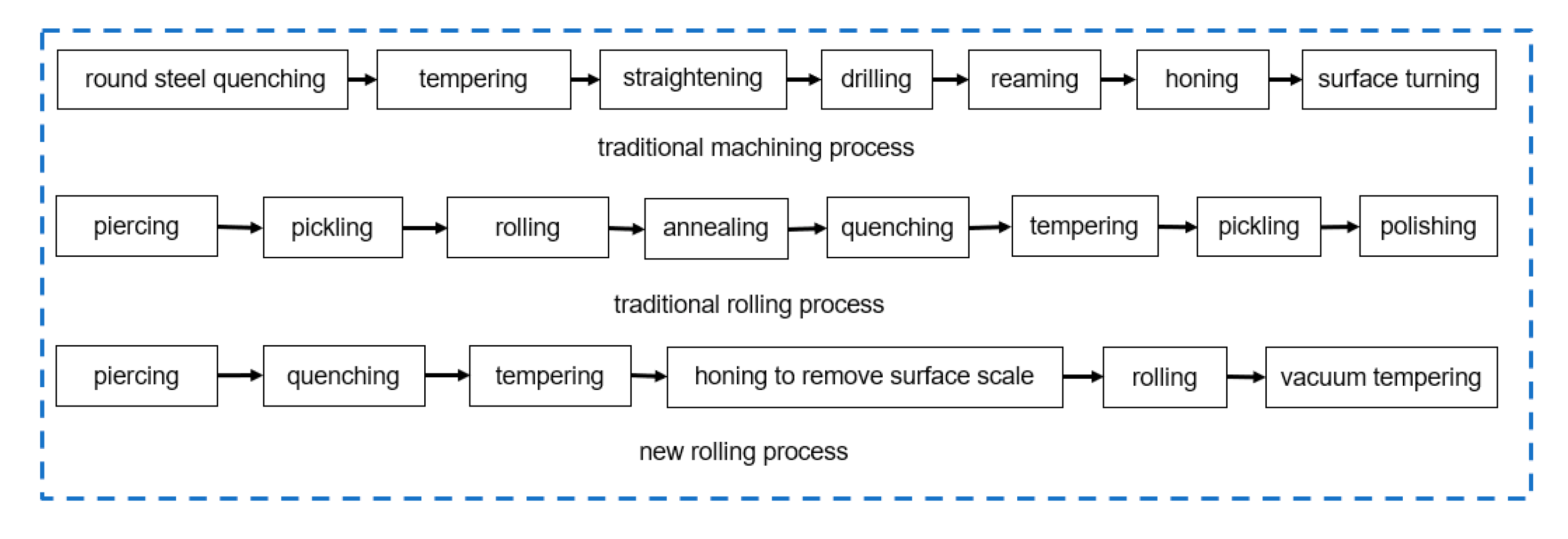
| C | Si | Mn | P | S | Ni + Cr + Mo | W | V | Fe |
|---|---|---|---|---|---|---|---|---|
| 0.29 | 0.19 | 0.14 | ≤0.015 | ≤0.015 | 5.0 | 0.37 | 0.63 | Bal |
| Mother pipe diameter | mm |
| Mother pipe inner roughness | 0.7~0.8 μm |
| Mother pipe hardness | 330~350 HV |
| Finished pipe after rolling | mm inner surface roughness ≤ Ra0.4 μm |
| Feed rate: m | 1~6 mm/stroke |
| Elongation of pipe: μ | 1.85 |
| Stroke speed: Vs | 80 strokes/min |
| Turn angle: θ | 53° [6] |
| Working length of wall thickness reduction | 370 mm |
| Roll die diameter | 300 mm |
| Feed Rate (mm/Stroke) | 1 | 2 | 3 | 4 | 5 | 6 |
|---|---|---|---|---|---|---|
| OD (mm) | 33.02 | 33.03 | 33.04 | 33.01 | 33.02 | 33.03 |
| ID (mm) | 11.01 | 11.02 | 11.01 | 11.04 | 11.00 | 11.03 |
| Conditions | Rm (MPa) | Rp0.2 (MPa) | A (%) | Z (%) | AKU (J) |
|---|---|---|---|---|---|
| Quenched and tempered | |||||
| Cold rolled | |||||
| Vacuum tempered |
Publisher’s Note: MDPI stays neutral with regard to jurisdictional claims in published maps and institutional affiliations. |
© 2022 by the authors. Licensee MDPI, Basel, Switzerland. This article is an open access article distributed under the terms and conditions of the Creative Commons Attribution (CC BY) license (https://creativecommons.org/licenses/by/4.0/).
Share and Cite
Li, R.; Zhang, X.; Zhang, C.; Wang, J.; Huang, J. Preparation of High-Precision Dimension Seamless Thick-Walled Pipe by New Cold Rolling Process. Metals 2022, 12, 1761. https://doi.org/10.3390/met12101761
Li R, Zhang X, Zhang C, Wang J, Huang J. Preparation of High-Precision Dimension Seamless Thick-Walled Pipe by New Cold Rolling Process. Metals. 2022; 12(10):1761. https://doi.org/10.3390/met12101761
Chicago/Turabian StyleLi, Ran, Xuewei Zhang, Cheng Zhang, Jiaming Wang, and Jinfeng Huang. 2022. "Preparation of High-Precision Dimension Seamless Thick-Walled Pipe by New Cold Rolling Process" Metals 12, no. 10: 1761. https://doi.org/10.3390/met12101761
APA StyleLi, R., Zhang, X., Zhang, C., Wang, J., & Huang, J. (2022). Preparation of High-Precision Dimension Seamless Thick-Walled Pipe by New Cold Rolling Process. Metals, 12(10), 1761. https://doi.org/10.3390/met12101761







